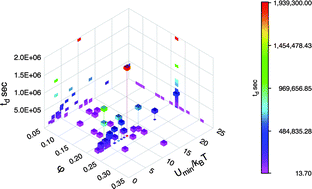Towards rationalising collapse times for the delayed sedimentation of weakly-aggregated colloidal gels
Abstract
By delayed sedimentation is meant the rapid collapse of a colloidal gel following a period of either little or no sedimentation. The delay or collapse time can range from seconds to many months, depending upon the strength of the gel. Delayed collapse is generally presumed to be a consequence of steady coarsening which somehow brings the gel to a critical state. Earlier work on very weak depletion gels demonstrated an exponential dependence of the collapse time on depletant concentration, implying that the activation energy for coarsening is equal to the mean binding energy of the particles, θ. This correlation is not however followed by the somewhat stronger secondary-minimum gels studied originally by Partridge, who first reported the phenomenon of delayed collapse. It is demonstrated here that the scaling on the mean binding energy becomes progressively more and more sub-Arrhenius as the latter is increased above ca. 10 kBT, also that the width of the potential well has an important effect. Between them, these two effects account for the faster than expected collapse shown by the secondary-minimum gels and by more strongly-flocculated depletion gels. It is suggested that apparent departures from Arrhenius scaling are a consequence of heterogeneity which causes the mean activation energy and the mean binding energy to differ as the energies become larger.


 Please wait while we load your content...
Please wait while we load your content...